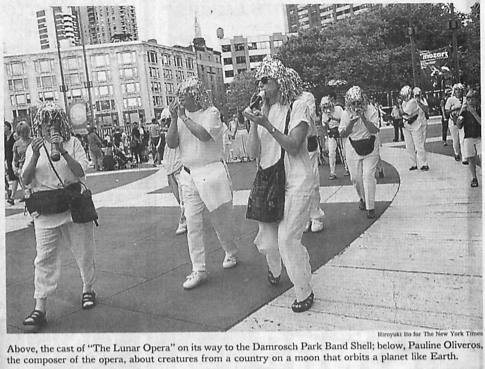Lunar Opera: Deep Listening For_Tunes

New York Times, August 19, 2000 On a Summer Night, Nothing Is Strange or Foreign By PAUL GRIFFITHS Probably it ought to matter whether someone is wearing the silver wig of a dancer in a cheap club or the yellow hat, high and crested, of a Tibetan monk. On Thursday, however, all the world was on stage at the Damrosch Park Band Shell -- all the world and also some strange moon, for the main event was "The Lunar Opera" by Pauline Oliveros, in which a variety of professional and amateur musicians were encouraged to do their own things while acting as creatures from Lunarus in what was decidedly Ms. Oliveros's own thing. |

Lunarus, according to the program, is a country "on the far side of the moon Anomaly, which orbits a planet very much like our own." The Lunarians should therefore have come across as a little more remote than the Tibetans who followed them on the platform, though it did not seem that way. The last hour of "The Lunar Opera" was a performance by the Deep Listening Band, who, had they changed into saffron and beet robes, could easily have stayed around to perform with the Drepung Loseling monks. Ms. Oliveros's deep listening is an ideal with which Tibetans are thoroughly familiar. The sound is complex and changes only very slowly, or else suddenly and unpredictably. It comes from long practice and immediate intuition, and it invites from the listener a swimming, meditative involvement. Even the means used by the Deep Listening Band and the Tibetans can be similar. Alongside the regular members of the band -- Ms. Oliveros on specially tuned accordion, Stuart Dempster on trombone and David Gamper on miscellaneous blown and shaken objects -- was Brenda Hutchinson, performing on her Long Tube instrument, which was effectively a high-tech, simplified-geometry Tibetan trumpet. Also playing was Hugh Ragin, who drew from a Western trumpet the overtones, steady pulses and rough sounds that are essential to music in Tibet. Presentation, too, was much the same from the inhabitants of Lunarus and of the Himalayas. Informality and wild claims characterized the spoken introductions. The performers were amplified and spotlighted. Audience appeal was an obvious priority. This was show business. The monks offered the throat singing for which they are renowned, with guttural noises producing halos of clear tone in the countertenor register. They also sang a melody by the 11th-century Ma-chik Lab-don, evidently a Tibetan Hildegard of Bingen, and presented a compact disputation, combining features of martial arts and television panel games. A student seemed to be answering questions from a teacher while the other members of the class had a whale of a time calling out and slapping their hands together, whether in encouragement or dispraise was not clear. These were holiday postcards in sound and action: Tibet for cultural tourists. Perhaps the same went for what was seen and heard from Lunarus. The best moment came when Mr. Dempster, blowing into a length of garden hose, went off on a hair-raising, savage lament, over electronic overlappings of chimes from Mr. Ragin's trumpet. A victory for passion. |
Ministry of Maåt
PoP&MoM (Pauline Oliveros Publications & Ministry of Maåt Publications)
Poster (Pauline in Moon) by Seana Biondolillo
Web page by Norman Lowrey
© Copyright 2000 Deep Listening Publications